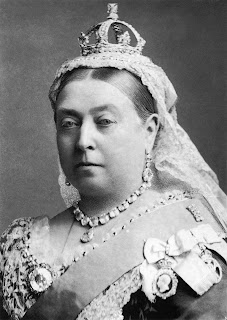Accession of Queen Victoria
Describing the accession of the British monarchy is seldom
easy to relate so hold on to your hat! Grab a drink and relax.
Queen Victoria was born on 24th May 1819 and died on the 22nd January 1901. However, her accession to the throne to become queen of the United Kingdom of Great Britain and Ireland wasn’t simply that having no brothers she succeeded after her father died, as is sometimes the case.
_(after)_-_Queen_Victoria_(1819%E2%80%931901),_as_a_Child_with_Her_Mother,_Maria_Louisa_Victoria_of_Saxe-Coburg-Saalfield_(1786%E2%80%931861),_Duchess_of_Kent_-_436114_-_National_Trust%20wiki.jpg) |
| Beechey- Victoria and her mother Princess Victoria of Saxe-Coburg-Saalfield |
Victoria acceded to the throne on the death of her uncle William IV on the 20th June 1837 and her coronation was on the 28th June 1838 at Westminster Abbey, London. She was the longest serving British monarch reigning for 63 years 216 days till the reign of Queen Elizabeth II, whose reign was 70 years and 214 days.
Queen Victoria’s reign was an era of vast improvements in the fields of medicine, industry, and science. Many of the achievements of the Victorian era regarding the expansion of the British Empire are no longer regarded as laudable but, at the time, they formed a huge part of Victoria’s success as a monarch.
Those are probably some of the most well-known facts about Victoria but how did she come to succeed after William IV?
 |
| Hayter - (painted 1838-1840) |
Victoria’s grandfather was King George III (sometimes unkindly called mad King George) and her grandmother was Queen Charlotte of Mecklenburg-Strelitz. They had 15 children: 9 sons and 6 daughters, though not all survived to the end of King George III’s long life. George III lived for 81 years and 239 days, his reign being of 59 years and 96 days. Not quite as long as the queens who followed him, but not shabby either.
For the last decade of King George III’s life he was medically unfit to reign and his eldest son, the Prince of Wales (George IV), became the regent and ruled in his stead. This period is often referred to historically as ‘The Regency’ era.
When Princess Charlotte, daughter and only child of the Prince Regent (George IV) died in 1817, it prompted a succession crisis. The surviving unmarried sons of George III were hastily wed, to do their duty and produce legitimate heirs, illegitimate offspring not considered for the succession! This list of unwed sons included Queen Victoria’s father Prince Edward.
Princess Victoria of Saxe-Coburg-Saalfield and Prince Edward, Duke of Kent and Strathearn, married in May and June 1818 (Lutheran and Church of England ceremonies), Prince Edward being the fourth son of King George III. At this point, Edward was already over fifty years of age. Alexandrina Victoria was born the following year on the 24th May 1819.
Unfortunately, when Victoria was only months old, Prince Edward died of pneumonia on the 20th January 1820, followed six days later by King George III. That didn’t immediately put Victoria next in the line of succession but she was inching her way up there!
On the death of King George III, George (the Prince Regent) officially became King George IV and reigned till his death in 1830. He was succeeded by William (IV) - the third son of George III - who reigned till 1837, at which time he died without issue.
The throne then fell to Victoria, though I have yet to work out why Prince Adolphus, Duke of Cambridge, the youngest son of King George III did not become king and Victoria did become queen! We’ll not confuse the situation here with mentioning Prince Ernest Augustus since he became the King of Hanover! …And another son of George III was forbidden the throne since he married a commoner (??). Clearly, some further research is required here as some of King George III's nine sons are not mentioned.
 |
| Bassano 1882 |
So, Victoria acceded to the throne at eighteen years of age having
been brought up with an expectation that should the worst happen to her uncles, she’d
become queen. She did and it seems her reign was a formidable one.
You’ll hear more of Victoria, her husband Albert, and her own children later in April. No guesses which letter will entitle that post!
See you tomorrow!
Slàinte!
https://commons.wikimedia.org/wiki/File:Coronation_portrait_of_Queen_Victoria_-_Hayter_1838.jpg
https://en.wikipedia.org/wiki/File:Queen_Victoria_by_Bassano.jpg


No comments:
Post a Comment
Thank you for reading my blog. Please pop your thoughts about this post in the comment box. :-)